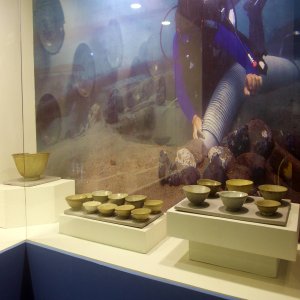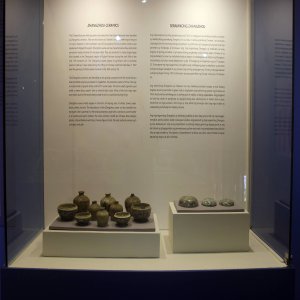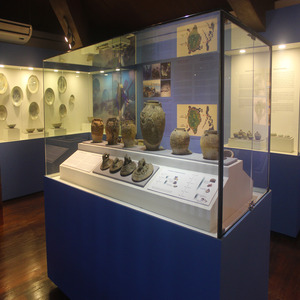| ‹ | Submerged History: Marinduque Shipwrecks |
› |
|---|
The “Submerged History” features the recovered artefacts from the underwater archaeological excavations of a shipwreck off Gaspar Island, Barangay Pinggan, Gasan municipality as well as the documentation of wooden ship remains in Barangay Laylay, Boac municipality.
The shipwreck found off Gaspar Island, Barangay Pinggan, Gasan was accidentally discovered by a local fisherman in November 1980. Archaeologists from the National Museum – Anthropology Division in collaboration with a private group and support from the Philippine Navy excavated the site from 1981 to 1983. A total of 1,260 artifacts were collected by the underwater archaeologist.
The Chinese blue – white porcelains recovered from the underwater excavation were identified as Zhangzhou ceramics also called as “Swatow” ceramics,produced by dragon- type kilns in the Zhangzhou region of Fujian Province during the mid-16th to the mid-17th centuries CE. They most appear in varying sizes of dishes, bowls, vases, boxes, jarlets and jars.
Dragon jars were also part of these archaeological finds, generally high-fired glazed stonewares with impressive dragon decorations. The Chinese believed the mythical animal was a symbol of power, strength and good luck and was commonly used to decorate different objects. Majority of the dragon jars have been produced by the kilns located in Guangdong and Fujian Province in China.
The shipwreck in Barangay Laylay, Boac was a landmark project of the National Museum of the Philippines.Underwater excavations from 2014 until 2016 resulted in the unearthing of wooden ship remains consisting of a keel approximately 28 meters long, planks, and other timber. Initial finds suggested that the wreck possibly belonged to a Spanish patrol boat dated to the late 18th century CE based on the type of cannons retrieved from the site.
The shipwrecks in Pinggan, Gasan and Laylay, Boac are direct material evidence of Marinduque’s active participation in local and international maritime trade that helped shape its current vibrant and remarkable culture.
Submerged History: Marinduque Shipwrecks is an exhibit in the National Museum Marinduque-Romblon that showcases the maritime heritage of the province of Marinduque, Philippines. The exhibit focuses on the shipwrecks that have been discovered in the waters surrounding the island, which offer insights into the region's history and culture.
The exhibit features artifacts recovered from the shipwrecks, including ceramics, glassware, and other objects that provide evidence of the trade and commerce that took place in the region during the Spanish colonial period. It also presents information about the historical context of the shipwrecks, including the trading routes and the economic and political climate of the time.
One of the highlights of the exhibit is the recreation of a Spanish colonial ship, which provides visitors with a sense of what life was like on board a ship during that time period. The exhibit also features interactive displays and multimedia presentations that allow visitors to explore the shipwrecks and learn about the various artifacts recovered from them.
Submerged History: Marinduque Shipwrecks is known for its engaging and educational presentation of Marinduque's maritime heritage. It highlights the importance of underwater archaeology in uncovering the region's history and culture, and emphasizes the need for the preservation and protection of these underwater treasures for future generations.



